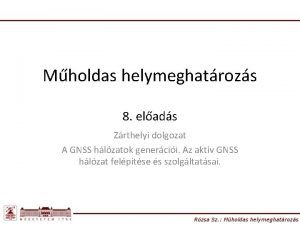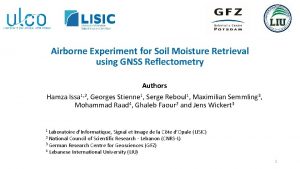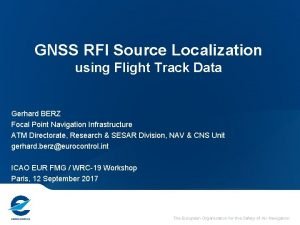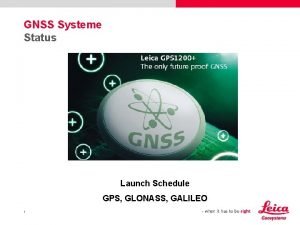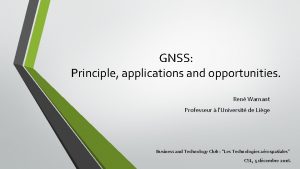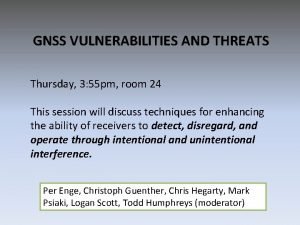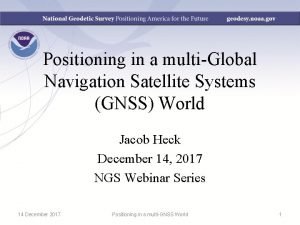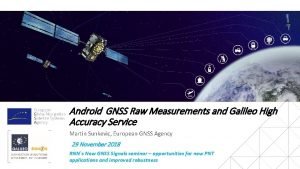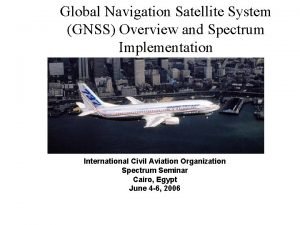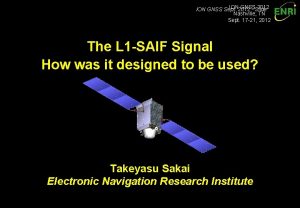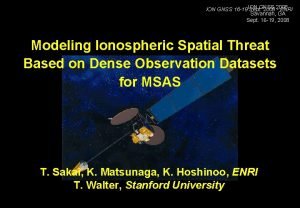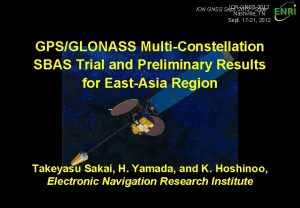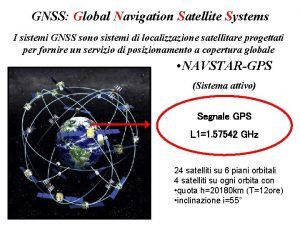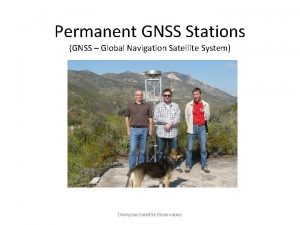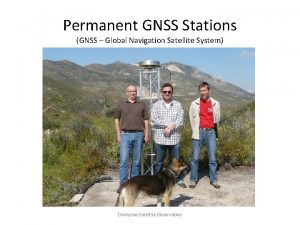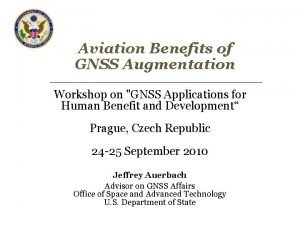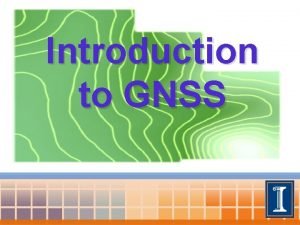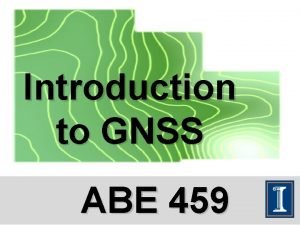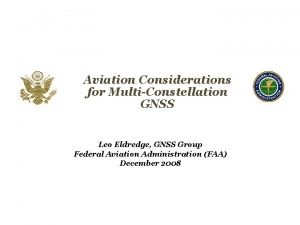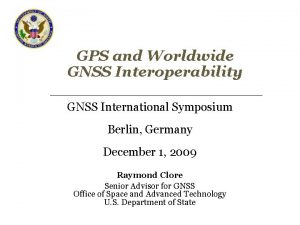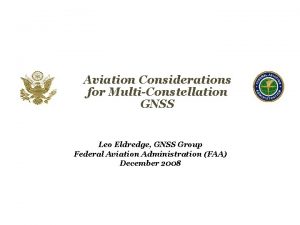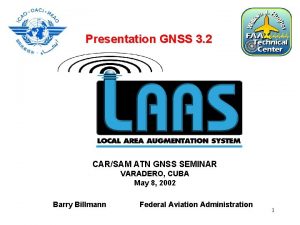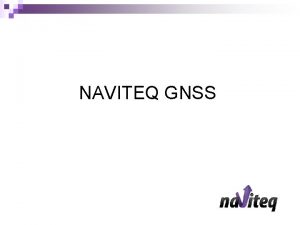ION GNSS 22 25 ION Sept GNSS 2009



























- Slides: 27

ION GNSS 22 -25 ION Sept. GNSS 2009 - ENRI Savannah, GA Sept. 22 -25, 2009 Modeling Vertical Structure of Ionosphere for SBAS T. Sakai, T, Yoshihara, S. Saito, K. Matsunaga, and K. Hoshinoo, ENRI T. Walter, Stanford University

ION GNSS 22 -25 Sept. 2009 - ENRI Introduction 1 • The ionospheric effect is a major error source for SBAS: – The SBAS broadcasts ionospheric correction messages as well as orbit and clock corrections; – The ionosphere varies day by day and difficult to predict the spatial distribution of ionospheric propagation delay based on the limited number of measurements; – Also known that the geomagnetic storm causes a large uncertainty. • Ionosphere modeled as a thin shell: – The current standard ignores height, thickness, and any vertical structure of the actual ionosphere; – For accuracy improvement, need to consider some models suitable for the SBAS to represent the vertical structure of the ionosphere. • Evaluation of the proposed models: – Modeling accuracy is improved by the multiple layer model.

ION GNSS 22 -25 Sept. 2009 - ENRI 2 SBAS Corrections Ionospheric Correction • Function of user location; • Up to 100 meters; • Vertical structure is described as a thin shell. Ionosphere Clock Correction • Same contribution to any user location; • Not a function of location; • Needs fast correction. Orbit Correction • Different contribution to different user location; • Not a function of user location; but a function of line-of-sight direction; • Long-term correction. Tropospheric Correction Troposphere • Function of user location, especially height of user; • Up to 20 meters; • Corrected by a fixed model.

ION GNSS 22 -25 Sept. 2009 - ENRI 3 SBAS Message Preamble 8 bits Message Type 6 bits Data Field 212 bits 1 message = 250 bits per second Transmitted First MT CRC parity 24 bits Contents Interval [s] MT Contents Interval [s] 0 Test mode 6 17 GEO almanac 300 1 PRN mask 120 18 IGP mask 300 Fast correction & UDRE 60 24 FC & LTC 6 6 UDRE 6 25 Long-term correction 7 Degradation factor for FC 120 26 Ionospheric delay & GIVE 300 9 GEO ephemeris 120 27 SBAS service message 300 10 Degradation parameter 120 28 Clock-ephemeris covariance 120 12 SBAS time information 300 63 Null message 2~ 5 120 —

ION GNSS 22 -25 Sept. 2009 - ENRI 4 SBAS IGP 60 Latitude, N 60 • Vertical ionospheric delay information at IGPs ( ) located at 5 -degree grid points will be broadcast to users. 45 • User receiver computes vertical ionospheric delays at IPPs with bilinear interpolation of delays at the surrounding IGPs. 30 • Vertical delay is converted to slant delay by multiplying a factor socalled obliquity factor. 30 15 IGP 0 0 120 150 Longitude, E 180 IPP IGP

ION GNSS 22 -25 Sept. 2009 - ENRI 5 Bilinear Interpolation IGP 2 IGP 1 IPP ypp IGP 3 xpp IGP 4 DIPP = xppypp. DIGP 1 + (1 -xpp)ypp. DIGP 2 + (1 -xpp)(1 -ypp)DIGP 3 + xpp(1 -ypp)DIGP 4 • User receiver computes ionospheric delay at the IPP by interpolation of delays at the surrounding IGPs.

ION GNSS 22 -25 Sept. 2009 - ENRI Generates IGP Data: Planar Fit 6 • The SBAS MCS needs to generate the vertical ionospheric delay information at every IGPs; Vertical Delay Cutoff Radius IPP Fit Plane IGP • Planar Fit algorithm is developed for US WAAS; Japanese MSAS employs the same algorithm; • Assume the spatial distribution of the vertical ionospheric delay around the IGP can be modeled as a first order plane; • Model parameters are estimated by the least square fit for each IGP; The estimated vertical delay is broadcast to users.

ION GNSS 22 -25 Sept. 2009 - ENRI Considering Vertical Structure 7 • The ionosphere has a certain vertical structure: – Currently modeled as a thin shell at fixed height of 350 km; – Suitable for a quiet ionospheric condition; How about for stormy condition? – For the SBAS, the ionosphere model must be simple; Needs consideration of the number of ionospheric correction messages. MODEL 1: Variable Height Shell Model: – – – Thin shell ionosphere model with a variable shell height not fixed at 350 km; Simple and less computational load both for the MCS and users; Needs to broadcast applied shell height; Only 2 to 4 bits. MODEL 2: Multi-Layer Shell Model: – – – Ionosphere modeled as the sum of multiple layers; Each layer represented as a thin shell with a certain height; The number of ionosphere correction messages increases proportional to the number of layers.

ION GNSS 22 -25 Sept. 2009 - ENRI 8 Thin Shell Ionosphere Vertical Delay Iv IPP Slant Delay Ionosphere EL F(EL) • Iv Shell Height Earth • • • The ionosphere model used by the current standard; Ionospheric propagation delay caused at a single point on the shell; The vertical delay is converted into the slant direction via the slant-vertical conversion factor so-called obliquity factor, F(EL).

ION GNSS 22 -25 Sept. 2009 - ENRI Obliquity Factor 9 • Slant-vertical conversion factor as a function of the elevation angle; • Also a function of the shell height; The current SBAS specifies the shell height of 350 km.

ION GNSS 22 -25 Sept. 2009 - ENRI 10 Slab Ionosphere Vertical Delay Iv IPP Slant Delay Ionosphere EL F • Iv Shell Height Earth • • • Assume that The ionosphere has a certain slab thickness; Slab structure with constant thickness lies above thin shell; How about obliquity factor F for this model. Slab Thickness

ION GNSS 22 -25 Sept. 2009 - ENRI 11 Slab Ionosphere (200, 0) (100, 0) (300, 0) Bottom height and Slab thickness (350, 0) (400, 0) (500, 0) (600, 0) • Slant-vertical conversion factor for the ionosphere with slab thickness; • The obliquity factor function for the ionosphere with a certain slab thickness is identical with the function for the thin shell ionosphere of a higher shell height.

ION GNSS 22 -25 Sept. 2009 - ENRI Variable Height Shell Model 12 • Thin shell model represents both: – There is a obliquity factor function used both for the slab ionosphere with a certain slab thickness and thin shell ionosphere of another shell height; – Thin shell ionosphere model with variable height shell represents the ionosphere both with and without slab thickness; Ignoring IPP relocation; – Problem is: How to measure appropriate shell height. (Method 1) Planar Fit Residual: – Residual error when the SBAS MCS estimates the vertical delay at IGP; – The performance (fitting accuracy) of planar fit depends upon the shell height set for computation. (Method 2) Bias Estimation Residual: – Residual error when the SBAS MCS estimates the instrumental bias error; – Estimation accuracy also depends upon the shell height.

ION GNSS 22 -25 Sept. 2009 - ENRI Planar Fit Residual 13 • Planar fit residual with respect to the shell height under a moderate storm condition of the ionosphere in July 2004; • Except higher part, the smallest residual appears at the shell height of 200 -300 km.

ION GNSS 22 -25 Sept. 2009 - ENRI Bias Estimation Residual 14 • Residual error in the estimation of instrumental bias, so-called interfrequency bias or L 1/L 2 bias; Depends upon the shell height; • Smooth against the shell height, but a little difference.

ION GNSS 22 -25 Sept. 2009 - ENRI 15 Measuring Shell Height Bias Estimation Planar Fit • Shell heights estimated based on (Grren) planar fit residual and (Red) bias estimation residual; • Planar fit residual results in lower shell height while bias estimation residual returns higher results; Bias estimation seems to have 1 -day period.

ION GNSS 22 -25 Sept. 2009 - ENRI 16 Multi-Layer Shell Model Iv(3) IPP 3 Iv(2) Ionosphere IPP 2 IPP 1 Iv(1) F(h 3, EL) • Iv(3) F(h 2, EL) • Iv(2) EL F(h 1, EL) • Iv(1) Earth • Ionospheric delay along with the ray path is represented as the sum of delays caused by multiple thin shells; Three layers for this example.

ION GNSS 22 -25 Sept. 2009 - ENRI Multi-Layer Shell Model 17 • Another way to represent the vertical structure of the ionosphere: – Ionospheric delay along with the ray path is represented as the sum of delays caused by multiple thin shells; – Each IGP has multiple delay values for the respective layers; – Still simple to compute the total slant ionospheric delay; – Need to determine the IGP delays for the multiple layers. • Known problem from the past Investigation: – Tend to be unstable due to a number of parameters to be estimated; – Sometimes negative delay appears at the middle layer. • Try with a new algorithm: – Residual Optimization algorithm; Originally developed to optimize the vertical ionospheric delay distribution, but for this time extended to slant delay.

ION GNSS 22 -25 Sept. 2009 - ENRI Past Investigation: Unstable Total Delay 18 1 st Layer at 250 km Similar Distribution 2 nd Layer at 350 km 3 rd Layer at 450 km Negative Delay

ION GNSS 22 -25 Sept. 2009 - ENRI Residual Optimization 19 • An algorithm to optimize ionospheric delays at IGPs [ION GNSS 2007]: – Ionospheric delays at IGPs can be optimized regarding the sum of residual error of IPP observations; – Define residual error between the user interpolation function and each observed delay at IPP, Iv, IPPi; – The optimum set of vertical delays minimizes the sum square of residuals; – The optimization can be achieved by minimizing the energy function (often called as cost function) E over IGP delays (See paper for detail): Function of IGP delays

ION GNSS 22 -25 Sept. 2009 - ENRI 20 Residual Optimization Vertical Delay IPP measurements Interpolated plane for users Adjust IGP delay to minimize residual Residual IGP i+1 Location • Adjust IGP delays so that the RMS of the difference between the interpolated ionospheric delay function for users and observed delays at IPPs is minimized.

ION GNSS 22 -25 Sept. 2009 - ENRI 21 IGP Location IPP 3 IGP Layer 3 IPP 2 Layer 2 IPP 1 Layer 1 • IGP is located at the same location of each layer; • IPP location on each layer is different from other layers; The set of surrounding IGPs may differ from each other.

ION GNSS 22 -25 Sept. 2009 - ENRI Ionosphere Layers at 13: 00 LT Total Delay 1 st Layer at 350 km 2 nd Layer at 600 km 3 rd Layer at 1, 000 km 22

ION GNSS 22 -25 Sept. 2009 - ENRI Ionosphere Layers at 01: 00 LT Total Delay 1 st Layer at 350 km 2 nd Layer at 600 km 3 rd Layer at 1, 000 km 23

ION GNSS 22 -25 Sept. 2009 - ENRI Residual Error (1) 24 1 -Layer Model 2 -Layer Model 3 -Layer Model Shell Height 1 -Layer: (350) 2 -Layer: (350, 600) 3 -Layer: (350, 600, 1000) • Residual error of three models with the different number of layers; • 2 -layer model reduces residual to half of 1 -layer; 3 -layer model reduces further; • Some periods that multi-layer models returns larger residual error.

ION GNSS 22 -25 Sept. 2009 - ENRI 25 Residual Error (2) 1 -Layer Model 2 -Layer Model 3 -Layer Model Shell Height 1 -Layer: (350) 2 -Layer: (350, 800) 3 -Layer: (350, 800, 1500) • Multi-layer models with higher shell heights; • Reduces residual error further; However the worst residual becomes larger.

ION GNSS 22 -25 Sept. 2009 - ENRI Conclusion 26 • Investigated some models to represent the vertical structure of the ionosphere to improve position accuracy of SBAS: – Variable Height Shell Model: Using thin shell model but the shell height is variable; – Multi-Layer Shell Model: Ionospheric delay is represented as the sum of delays on multiple thin shells with different shell heights. • Evaluation of the proposed models: – Difficult to measure the proper shell height for Variable Height Shell Model; – Multi-Layer Shell Model reduced residual error; The residual optimization algorithm worked functional while the past investigations had problems of unstable solution. • Further investigations: – – – Analyze and prevent large residual situations for multiple layer models; Consider to use a priori information for modeling; Temporal variation and scintillation effects.
 Cnn 10 september 20 2021
Cnn 10 september 20 2021 Un deux trois quatre cinq six
Un deux trois quatre cinq six Sept
Sept Les arbres des villes poésie georges drouillat
Les arbres des villes poésie georges drouillat Sept heure moins le quart
Sept heure moins le quart Deportes
Deportes I sept
I sept Ecrivez les sept jours de la semaine
Ecrivez les sept jours de la semaine Accu poole sept
Accu poole sept La guerre de sept ans
La guerre de sept ans Sept comme setteur questionnaire
Sept comme setteur questionnaire Sept commandements
Sept commandements Suture to stabilize suffix
Suture to stabilize suffix Jerusalem 7 hills
Jerusalem 7 hills Gnssnet
Gnssnet Gnss site calibration
Gnss site calibration Gnss
Gnss Matlab stanford
Matlab stanford Pnt gnss
Pnt gnss Force full gnss measurements
Force full gnss measurements Galileo satelliten status
Galileo satelliten status Resilient pnt
Resilient pnt Three segments that make up a gnss
Three segments that make up a gnss Gnss
Gnss Gnss vulnerabilities
Gnss vulnerabilities Gnss
Gnss Force gnss measurements
Force gnss measurements Gnss receiver
Gnss receiver














